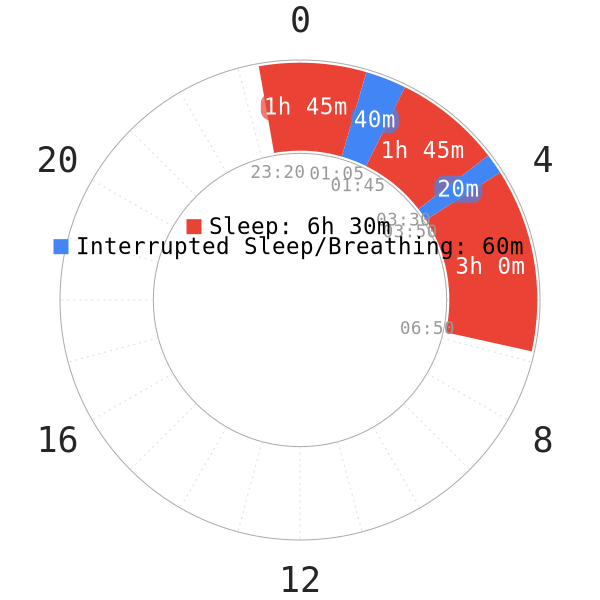Introduction
Relaxing muscles in the throat are behind sleep apnea, which results in the airway being blocked1. This causes a drop in blood oxygen saturation, which arouses your brain from sleep and releases adrenaline. Many people are not even aware of these arousals. If you have sleep apnea without treatment, your brain partly wakes you up when your airway collapses. Specifically, when your blood-oxygen starts to drop due to the inability to breath.
When you wake up, your throat muscles tense up again, and breathing resumes. Oftentimes, you will not become conscious when this happens, so you may be unaware of the symptoms.

- This cycle of sleeping > airway collapses > arousal > breathing resumes > return to sleep can happen many times per hour1.
- Less than 5 events per hour is normal, 5-15 is minor, 15-30 is moderate, and more than 30 per hour is severe2. What this means is that the brain cannot fall into SWS for more than a couple of minutes at a time depending on the severity. Therefore, the overall sleep quality becomes very poor3.
- Sleep apnea can heavily disrupt sleep continuity.
Risk factors
Risk factors for developing sleep apnea include the following16:
- Overweight
- Snoring
- Retaining tonsils
- Having a large neck circumference
- Not sleeping in a lateral position
- Other genetic factors which mostly have to do with neck/jaw/facial structure.
Possible Sleep Apnea Treatments
There are several methods of treatment, depending on severity.
- By far, the most common is using a CPAP machine (Continuous Positive Airway Pressure). It inflates the lungs and airways, preventing them from collapsing1.
- For less severe cases, a dental appliance is viable, which simply holds the tongue towards the front of the mouth4.
- More severe cases can find a CPAP machine too uncomfortable, claustrophobic, or cannot adapt to breathing with a CPAP machine. Thus, speak with doctors for more alternatives.
Polyphasic Sleep Suitability
Because polyphasic sleep relies on optimizing sleep, adapting to a schedule will not be possible without the proper treatment for the disorder. A proper treatment of sleep apnea combined with no trouble falling asleep quickly will restore sleep quality. At this point, attempting a polyphasic schedule becomes possible.
Up to date, there are no reports on successful polyphasic adaptations with sleep apnea.
Main author: Crimson & GeneralNguyen
Last page update: 2 April 2021
Reference
- Löhlein D. [Nutritional requirements in long-term artificial nutrition]. Beitr Infusionther Klin Ernahr. 1986;14:1-8. [PubMed]
- Lévy P, Kohler M, McNicholas W, et al. Obstructive sleep apnoea syndrome. Nat Rev Dis Primers. 2015;1:15015. [PubMed]
- McArdle N, Douglas N. Effect of continuous positive airway pressure on sleep architecture in the sleep apnea-hypopnea syndrome: a randomized controlled trial. Am J Respir Crit Care Med. 2001;164(8 Pt 1):1459-1463. [PubMed]
- Gotsopoulos H, Chen C, Qian J, Cistulli P. Oral appliance therapy improves symptoms in obstructive sleep apnea: a randomized, controlled trial. Am J Respir Crit Care Med. 2002;166(5):743-748. [PubMed]
